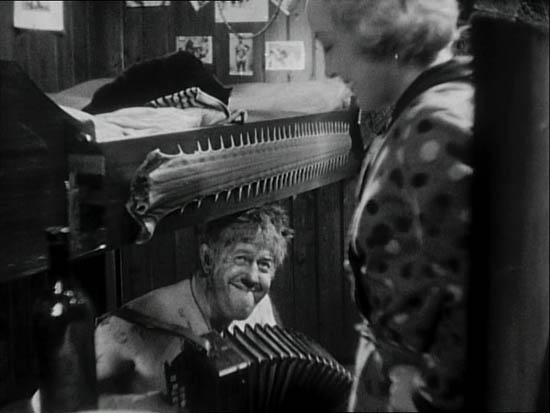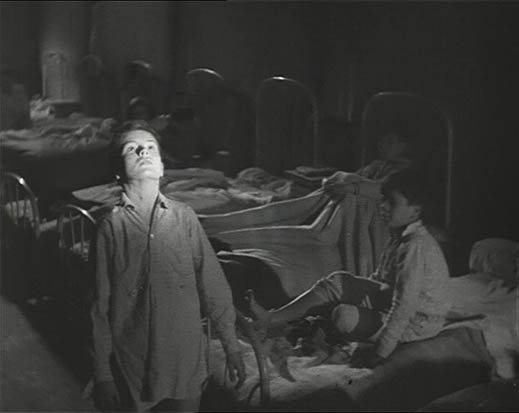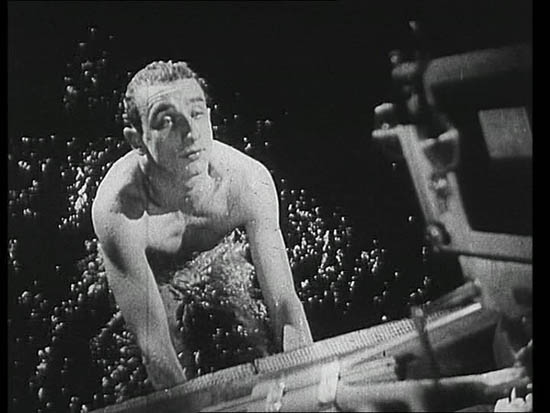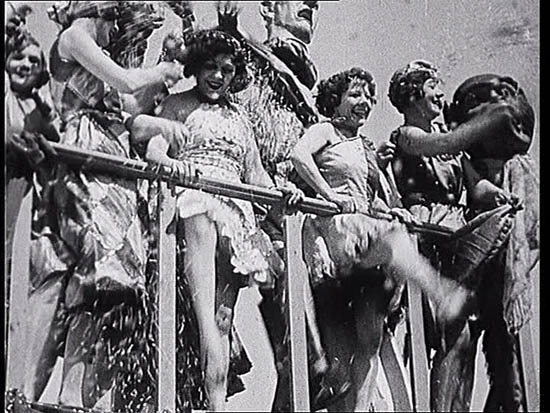I am pleased to say that the movie never quite dives into gritty, depressing realism. It seems like it will… I mean, the second scene is set in a horrible homeless shelter with our hero lying half dead on the floor, his leg smashed after a car ran over it, being dragged unconscious into the showers by the shelter’s other miserable-looking occupants. But forty minutes later he is motoring down the Seine towing Juliette Binoche on waterskiis, surrounded by fireworks in what must’ve been one of the most exuberant film sequences of the decade. When he’s sick of it, he throws away his crutch and in the next scene his cast is gone too. The movie reminds us of real-world problems but its heroes are above them… homeless, sick, injured, lonely, hungry, fighting with each other, but never so bad that the next scene can’t fix everything.
Guy with the busted leg is Alex, resourceful homeless guy who lives on the under-construction bridge with his scary mentor Hans (who dispenses whatever drug Alex needs to sleep at night). Binoche is heartbroken Michelle who was a painter before she started going blind and ran away from her treatment. After they fall in love, Alex rebels when he hears that a search is on to find and cure Michelle, preferring her to be dependent on his care. But she finds out and gets the cure, while he inadvertently lights a guy on fire and goes to jail for a couple years. Very romantic-comedy-like, they make a date to meet on Christmas on the repaired bridge and end up together. Sounds dreadfully obvious, and it does get a bit indie-film-cutesy, but the love story and the ballsy storytelling pulled me right in… loved the movie.
Binoche was nominated for a best actress Cesar, but running against Emmanuelle Beart for La Belle noiseuse and Irene Jacob for Double Life of Veronique, the “brave young actress in awesome art film” vote was split, and the award went to elder Jeanne Moreau for a comedy I’ve never heard of. But up against a completely different group of actresses, Binoche took the European Film Award that year. Denis Lavant, also star of Carax’s Bad Blood and Denis’s Beau travail, unsurprisingly (because he’s funny-lookin’) later appeared in A Very Long Engagement. Hans was Klaus-Michael Grüber, previously a director for television, who has appeared in nothing else.

Learned some stuff on other sites. Everyone wants to talk about the movie’s huge spiraling budget as Carax, unable to use the bridge itself, built a new bridge (and the surrounding buildings!) over a lake for a movie set. And everyone wants to talk about the movie being a flop upon release in theaters. And Americans want to gripe about the nine-year-delayed release to theaters here. And everyone makes a point of mentioning that Leos Carax is a made-up name, but I only saw one mention that the character Alex is a stand-in for the director (real name Alex), who was dating Juliette Binoche while this was in production. Also found plenty of comparisons to other films:
Titanic – for the ending (“king of the world” bit on the barge), fact that it’s a super-expensive movie but plot is a simple two-person love story.
One From The Heart – for the romantic tone, but mostly for the huge, awesomely expensive artificial set created for the movie, and the subsequent damage to the director’s career after the movie was not well-received.
City Lights – blind girl, in love with a homeless man, regains her sight at the end. Clearly an influence on the story.
L’Atalante – ahh, there’s the one Carax probably had in mind. Protagonists are poor but resourceful, in love but in a rocky relationship, joined by a moody father-figure old man, end up together on a barge. Perfect.









